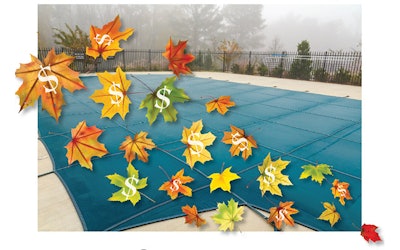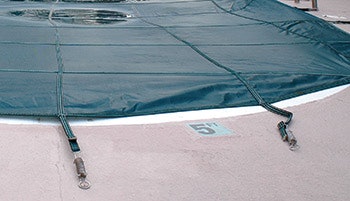
In many parts of the U.S. and Canada, spring was unusually cold this year as winter conditions hung on as late as May. Servicers along the East Coast and throughout the Midwest report that the cold weather caused delays in pool openings and in some cases forestalled necessary repairs.
The tough conditions also caused wear and tear on winter covers that could lead to replacements and upgrades for some. Taking advantage of those opportunities means beginning those discussions with clients in the latter part of summer, when they consider budgeting for a new cover or an upgrade.
"This past winter was pretty bad and winter covers have taken a beating, so we will likely see a lot of interest in upgrading and replacing winter covers this season and into the fall," says Mike Mancini, general manager for Fox Pools & Marquis Spas and Leisure Centre in Ontario, Canada.
"There is definitely a trend toward upselling customers into purchasing a safety cover over a standard vinyl tarp."
THE SOLID TARP OPTION
We'll start with one of the least expensive options. Although a spectrum of more advanced options exist, the basic vinyl tarp, often secured around the pool edges using the weight of water bags, holds a segment of the market largely for two reasons. First: It has a low price point. Second: It allows homeowners to cover the pool in winter without altering the deck finish with anchors and holes safety covers require.
Affordable aboveground pools are often prime candidates for the non-safety, vinyl tarp. The affordability of the category does, however, come at the expense of labor required to place the cover in spring and remove and store it come fall.
 After installation of a winter pool cover it's possible for straps to lose tension and become displaced as shown. For proper functionality, the cover should be checked periodically and adjusted to maintain taught, complete coverage.
After installation of a winter pool cover it's possible for straps to lose tension and become displaced as shown. For proper functionality, the cover should be checked periodically and adjusted to maintain taught, complete coverage.
"When opening a pool with the old tarp covers, we can easily spend at least 30 minutes pumping water off the top of the cover," Mancini says. "Plus, the water bags need to be replaced frequently — five years is a long life for a water bag. Therefore, when everything is said and done, installing a safety cover can represent considerable annual savings for the pool owner."
Solid tarps also require periodic cleaning during winter and, as Mancini says, the use of a cover pump to evacuate water, a factor that can itself require caution. Heavy rains, snows and wind can deposit large amounts of debris on covers, causing them to become unsightly and possibly become dislodged. And older tarps with small holes can cause additional issues: As the cover pump drains surface water, pool water can flow up through the holes in the tarp, so now you're pumping out pool water.
Tarp manufacturers have made improvements to make their products more convenient and durable. Fox Pools, for example, now offers a "lock in" cover system in which the cover attaches to the pool's coping below the deck, eliminating the need for water bags and much of the deck clutter associated with solid tarps.
STRAPS AND ANCHORS
Strap and anchor systems represent a set of upgrade options for many homeowners who may have grown weary of the time and expense that comes with solid tarp covers. Available in a variety of configurations, and solid or mesh material (with some hybrid models that offer the advantages of both), these products are considered "safety" covers and can be made to fit most any type of pool.
"We always include a standard vinyl safety cover in our new pool construction package with an additional cost to upgrade to a safety cover, but today's pool designs don't really lend themselves to standard winter covers," Mancini says. "Water features and retaining walls alone make it virtually impossible to use a standard winter tarp."
The same can be true of pools with attached raised spas, vanishing edges, artificial rockwork and other design features. In those situations, strap and anchor safety covers may be the only option for winterizing, which also holds true in comparison to automatic safety covers, which typically require rectangular pool shapes.
According to custom-pool builder Steve Edwards, owner of Edwards Pool Construction in Andover, Kan., "I'm a big fan of mesh covers, which we use in many of our freeform pools. I've worked with simple solid covers in the past and the hassle of cleaning and storing them just isn't worth it. The mesh safety cover is a much better option."
"In addition to backyard security and beautification, safety covers — no matter the color — also save pool owners money," says Mancini. "A safety cover will last a minimum of 10 years and is easy to install and remove. But more importantly they also help to reduce the length of time it takes to open a pool."
As mentioned above, many of the features that attend today's custom pools make covering them a challenge, regardless of the cover type. As a result, manufacturers of anchored covers have developed anchor systems that can be used on vertical surfaces, over vanishing edges and raised bond beams, perimeter overflows and on lawns and other softscape surfaces.
In some cases, manufacturers outside the cover category have offered anchoring solutions. For example, Rico Rock, an artificial rock manufacturer, offers threaded inserts for eyebolts and cable that facilitates securing safety covers to rock structures.
For these and other reasons, safety covers are a logical upgrade for many homeowners. "We find customers who had a standard vinyl winter cover installed when they first had their pool built are interested in a safety cover when it comes time to replace the cover," Mancini says. "They have seen their neighbor's pools which have safety covers and realize how much cleaner the pool looks."
Comments or thoughts on this article? Please e-mail Eric at [email protected].







































